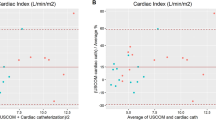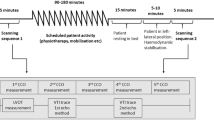Abstract
This study sought to validate a new noninvasive method to measure cardiac output, in the clinical setting, using color Doppler flow integration. This method, the automatic cardiac output measurement (ACOM), using color Doppler was recently developed and validated in vitro. ACOM was performed at the aortic valve and in the left ventricular outflow tract in 106 subjects (60 men, mean age 52 ± 18) and compared with the echocardiographic pulsed-wave Doppler and a 2-D volume method. In 14 patients the noninvasive methods were correlated with the thermodilution technique. ACOM was feasible in 101 subjects (95%). The correlation factor between the values obtained with ACOM in the apical 5-chamber view and apical long-axis view was 0.75 at the aortic valve and 0.74 in the left ventricular outflow tract. Interoperator variability for ACOM in the apical 5-chamber and apical long-axis views were 0.93 and 0.75, respectively. The best comparison of ACOM with the pulsed-wave echo-Doppler technique occurred in the apical long-axis view (n = 79, r = 0.62), whereas the correlation with the 2-D volume method was poor. The most favorable comparison of ACOM with the thermodilution technique (n = 14) was also obtained in the apical long-axis view (5.408 ± 1.72 vs. 3.356 ± l.281/min. [mean ± SD], r = 0.71). Assuming the thermodilution technique as ‘gold standard’, the pulsed-wave echo-Doppler technique showed a better correlation (5.408 ± 1.72 vs. 4.664 ± l.281/min., r = 0.84). ACOM is a useful, reproducible, noninvasive tool for rapid automated measurements of cardiac output. There is, however, an underestimation when compared with the pulsed-wave Doppler echocardiography and the thermodilution techniques. Good 2-D echocardiographic images, adequate color filling of the outflow tract and high frame rates are prerequisites for accurate values. Further refinements of this new technique are needed to enhance its clinical value in the future.
Similar content being viewed by others
References
Branthwaite MA, Bradley RD. Measurement of cardiac output by thermal dilution in man. J Appl Physiol 1968; 24: 434-438.
Schuster AH, Nanda NC. Doppler echocardiogaphy. Part I: Doppler cardiac output measurements: Perspective and comparison with other methods of cardiac output determination. Echocardiography 1984; 1: 45.
Huntsman LL, Stewart DK, Barnes SR, Franklin SB, Colocousis JS, Hessel EA. Noninvasive Doppler determination of cardiac output in man: Clinical validation. Circulation 1983; 67: 593-602.
Lewis JF, Kuo LC, Nelson JG, Limmacher MC, Quinones MA. Pulsed Doppler echocardiographic determination of stroke volume and cardiac output: Clinical validation of two new methods using the apical window. Circulation 1984; 70: 425-431.
Tsujino H, Shiki E, Hirama M, Iinuma K. Quantitative Measurement of Volume Flow Rate (Cardiac Output) by the Multi-beam Doppler Method. J Am Soc Echocardiogr 1995; 8: 621-30.
Pu M, Tsujino H, Vandervoort PM, Thomas JD. Automatic measurement of forward flow using color Doppler flow integration: In vitro validation in a pulsatile method (abstr). J Am Soc Echocardiogr 1995; 8: 37D.
Schiller NB, Shah PM, Crawford M, DeMaria A, Devereux R, Feigenbaum H, Gutgesell H, Reichek N, Sahn D, Schnittger I, Silverman NH, Tajik AJ. Recommendations for quantitation of the left ventricle by two-dimensional echocardiography. J Am Soc Echocardiogr 1989; 2: 358-367.
Sun JP, Pu M, Fouad FM, Christian R, Stewart WJ, Thomas JD. Automated cardiac output measurement by spatiotemporal integration of color Doppler data. Circulation 1997; 95: 932-939.
Nesser HJ1, Dennig K2, Tkalec W3, Drozdz J3. Color Doppler flow integration, a new diagnostic tool for assessing cardiac output. (1General Hospital St. Elizabeth, Linz, Austria, 2German Heart Center, Munich, Germany, 3University Clinic, Lodz, Poland, Toshiba Internal Document, 1995).
Shakudo M, Yoshikawa J, Yagi T, Watanabe H, Yamamuro A, Hozumi T et al. A new method for determining stroke volume by color Doppler flow velocity profile: Stability to a positional change of sample area (abstr). J Am Soc Echocardiogr 1995; 8: 39D.
Author information
Authors and Affiliations
Rights and permissions
About this article
Cite this article
Trindade, P.T., Brown, P., Puryear, J.V. et al. Automatic Cardiac Output Measurement (ACOM): Clinical applications of a new noninvasive tool. Int J Cardiovasc Imaging 14, 147–154 (1998). https://doi.org/10.1023/A:1005909507678
Issue Date:
DOI: https://doi.org/10.1023/A:1005909507678




